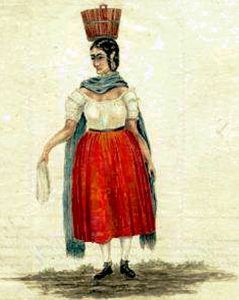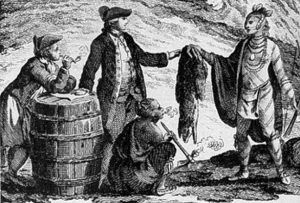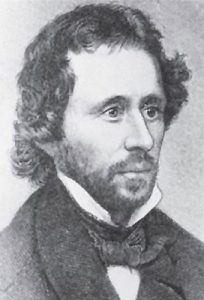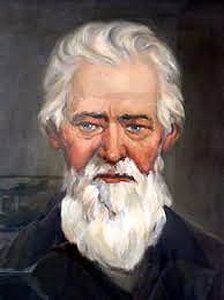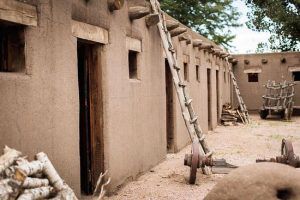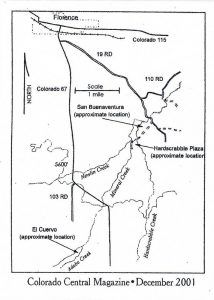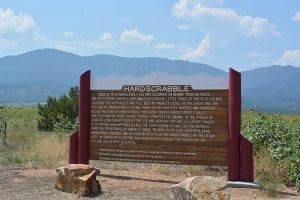In about 1843, Mexican landowner Charles Beaubien, who lived in present-day New Mexico, established the short-lived Mexican settlement of San Buenaventura de Los Tres Arrollos near the confluence of Adobe, Hardscrabble, and Newlin Creeks in Colorado. He brought several Taos, New Mexico, farmers, and their families to the location about five miles northeast of Fort LeDuc. However, with the constant threat from Indians, the settlement was short-lived, and Beaubien soon returned to Taos.
At about the same time, Matthew Kincaid established a ranch about six miles above the Mexican town at the mouth of Hardscrabble Creek. There, he built a house of upright logs, which became the headquarters of his cattle ranch.
In 1844, three traders from El Pueblo, about 23 miles to the east, including George Simpson, Joseph Doyle, and Alexander Barclay, came to the abandoned Mexican settlement and established a trading post. The name was soon changed to Hardscrabble because, according to George Simpson, it was “hard scrabbling to get in a crop” in the gravelly soil.
The Hardscrabble area had long been a favorite spot for the early Indian tribes, including the Ute, Cheyenne, Sioux, Kiowa, and Arapaho.
The traders built walls and flat-roofed adobe houses, which formed a protective plaza to defend against Indian raids. The walls contained a trading post and a dozen or so adobe rooms. The proprietors of the trading post, Simpson, Barclay, and Doyle, and their families lived within the plaza. Some of the rooms were probably used as storage rooms, trading rooms, blacksmith shops, dining halls, and kitchens, as was usual in trading posts of this time. Hired hands also constructed their own dwellings near the creek.
British trader Alexander Barclay lived there with his wife, Teresita Sandoval, who had previously been Matthew Kinkaid’s common-law wife. George Simpson had earlier married Teresita’s daughter, Juana Maria Suaso. In the same year that Hardscrabble was established, Joseph Doyle married Maria De La Cruz “Cruzita” Suaso, another of Teresita’s daughters.
On June 2, 1844, George Simpson and his wife had a daughter at Hardscrabble named Maria Isabel. She was heralded in several newspapers as the first white child born in Colorado. Other children, born without much fanfare at the Hardscrabble settlement, were a son, Joseph Robert, born to the Simpsons in 1846, and Elena, daughter of Marcellina Baca and his Pawnee wife, the same year.
Though the settlement’s main objective was the trading post, most of the people made their livings by farming. It was one of the first places in the state to be cultivated, irrigated, and settled. However, it was also prone to drought and soon suffered from overgrazing.
A contemporary description of the Hardscrabble settlement appeared in a St. Louis newspaper in the early summer 1845 stated:
“Hardscrabble: This is the name of an agricultural settlement on the waters of the Arkansas River, near the base of the Rocky Mountains. It consists of about twenty-five families, old trappers, and hunters who have built houses and devoted themselves to agriculture. They all have Indian wives of the Snake tribe, they being much preferred to the Indians of the plains, who are nearest to them. They raise considerable quantities of corn, which they trade to the Indians for furs, robes, and other articles. The Indians parch the corn and bruise and pound it into meal in skin bags and then make bread out of it. The settlers in Hardscrabble have no mills except a few indifferent hand mills, with which they grind corn for their own use. These men are very expert riflemen, well-practiced in Indian usages and warfare, and consider themselves against all the Indian tribes of that region if they should be attacked by them. They live a rough, hard, romantic life, but are hospitable to those who visit them or pass through their settlement.”
Expedition leader John C. Fremont passed the settlement in 1845 and called it ”Pueblo of S. Charles” to distinguish it from El Pueblo, further to the east.
In about 1846, Mrs. Felipe Ledoux visited Hardscrabble and described the people living there. Mrs. George Simpson added to her description. At that time, Joseph Doyle and George Simpson still lived with their families in the plaza, but Alexander Barclay had built a house a little above the plaza opposite another house owned by Valentine “Rube” Herring. John Burroughs and Calvin Briggs, who were brothers-in-law, married to Snake Indian sisters, shared a jacal cabin. Marcellina Baca, a comparatively wealthy Indian trader, lived in a house on a rise of ground about an eighth of a mile southwest of the plaza. A family of Tafoyas, including Marcellina and Francisca, lived near the plaza, as did B.A. Jones, who worked for Doyle.
Other employees, traders, and ranch hands lived in cabins that were strung along Hardscrabble Creek between the plaza and Kincaid’s ranch house. These included Jean Paisel, a hunter for the plaza (who was probably John Poisel, a well-known trader whose daughter Maggie married Thomas Fitzpatrick), Juan and Francisco Martin, two Frenchmen by the names of Sixhommes and La Fontaine, Maurice LeDuc, Gagnez, and a man named Tom Whittlesey with his woman Candelaria Sena.
While Mrs. Ledoux was at Hardscrabble, resident Tom Whittlesey thought his woman, Candelaria Sena, was having an affair with La Fontaine and killed the Frenchman. He also killed and dismembered Candelaria. When the people of Hardscrabble heard about the murders, they were revolted, and Whittlesey fled to Pueblo.
In December 1846, Lancaster Lupton, the former owner of Fort Lupton farther north in Colorado, arrived in Hardscrabble. He bought or rented a building from Alexander Barclay, where he opened a store. His account books mention several other names of people living in the area, including Estes, Garnier, William Howard, and John Brown. Lupton arrived just before some of the older settlers started to move away. By this time, the demand for beaver pelts had sharply declined and was being replaced by trade in buffalo hides. Hardscrabble was far from the buffalo herds.
By 1847, the Ute Indians’ fiercest foes were the Arapaho, Cheyenne, and Sioux, and several skirmishes had occurred between them. That year, a battle between the Ute and an Arapahoe-Mexican alliance was fought near Kinkead’s ranch about six miles above the Hardscrabble. While the battle raged, Luz Metcalf, Terracita Barclay, Juana Simpson, and Cruz Doyle stood in the Hardscrabble plaza and listened to the reports of guns. Ultimately, the Ute were victorious and soon arrived at Hardscrabble, where they demanded a victory feast. The women prepared a meal with great quantities of bread, buffalo meat, and corn. Afterward, the Ute left and never returned there to trade.
Because of the hostile Indians, the decline in the fur trade, and poor crops, the settlers of Hardscrabble began to leave. In the summer of 1847, Matthew Kinkead abandoned his cattle ranch and later went with John Brown, Jim Waters, and other settlers of Hardscrabble and Pueblo to California. Tradition says they all got rich.
That same year, Turley’s Mill near Taos, New Mexico, the largest distillery and dispenser of “Taos Lightning,” was destroyed during the Taos Revolt. The trading post at Hardscrabble had long been an alcohol supplier to the Indians, from which they made much of their profits.
In the meantime, Marcellina Baca and his Pawnee wife moved to a small settlement in the Greenhorn Valley. Simpson, Barclay, and Doyle spent the winter of 1847 at Pueblo, then left in the spring of 1848 to build Fort Barclay on the Santa Fe Trail in northeast New Mexico.
After the Mexican-American War ended in 1848, the Santa Fe and Oregon Trails became the highways between the States and the newly acquired territories of New Mexico and California, leaving Hardscrabble high, dry, and useless between these two great traffic arteries.
By then, only a few settlers were left in Hardscrabble, including Lancaster Lupton, Calvin Briggs, John Burroughs, Valentine “Rube” Herring, a man named Noverto, and a few hired hands.
In November 1848, John C. Fremont was on another expedition and stopped in Pueblo to hire men to guide him over the mountains as he looked for a route for the railroad. Old Bill Williams and “Uncle Dick” Richens Wooton signed on. On November 23rd, Fremont and his 30-odd men and 120 mules arrived at the Hardscrabble settlement, which he described as ”a miserable place containing about a dozen houses, corn cribs, and corrals. It is the summer resort of the hunters – the houses are built of adobe and are very comfortable — they seemed like palaces to us, as we enjoyed the luxuries of table & stools…”
Lancaster Lupton sold 130 bushels of shelled corn to Fremont and his men, which were packed on the backs of the mules. The expedition moved up Hardscrabble Creek on November 25th, wading through deep snow in the bitter cold, and when they caught sight of the Sangre de Cristo Mountains, Dick Wootton exclaimed, ” There is too much snow ahead for me,” and turned back towards Hardscrabble. Wootton’s instinct was right as the expedition ended up in the frigid San Juan mountains, where ten men died and more than half of the mules ”froze stiff.” Benjamin Kern and “Old Bill” Williams were later killed while retracing the expedition trail to look for gear and survivors. In the meantime, after recuperating in Taos, Frémont and only a few of the men left for California via an established southern trade route.
Lancaster Lupton was probably the last person to leave the Hardscrabble settlement. He and his family left for California in 1849.
In 1852, Spanish-speaking families tried to settle around the Hardscrabble plaza but met with resistance from Ute Indians and soon left. The next year, Lieutenant Edward Beckwith, a Corps of Topographic Engineers member, passed by Hardscrabble and described it as deserted.
The old adobe buildings of the plaza still stood in 1859, but soon after, other settlers used the adobe bricks, and all traces of the settlement disappeared. The site later became part of a ranch.
A historical marker is located seven miles south of Florence, Colorado, entitled “Hardscrabble.”
Indeed, the men who have located here are all those whom the wreck of the mountain trade and hunting parties have left on the surface, unfitted to return to former haunts or avocations, with minds alienated by new convictions from home and early friends, and habits transformed by constant excitement and daring adventure from the dull plodding of the sober citizen to the reckless activity and thrilling interest of a border life, open to the aggression of the savage and the pursuit of free will, free trade, and free thinking.
—Alexander Barclay, in a letter about life in Hardscrabble
©Kathy Alexander/Legends of America, updated April 2024.
Also See:
Sources:
Colorado Historic Marker
Cozine
Lecompte, Janet S.; Colorado Magazine, State Historical Society of Colorado, April 1954
Wetmore, Colorado Historical Society


